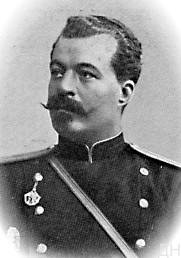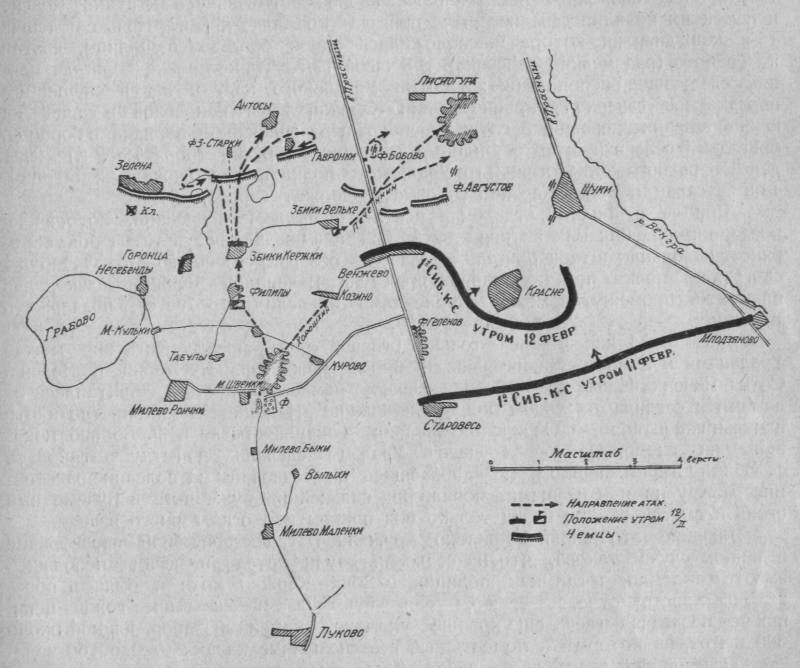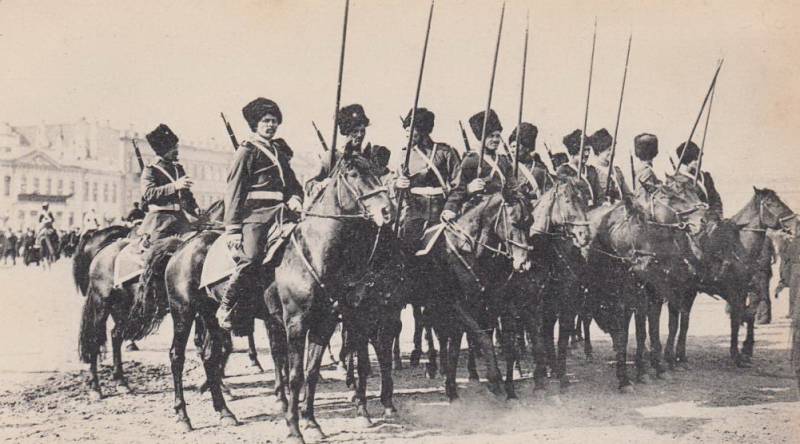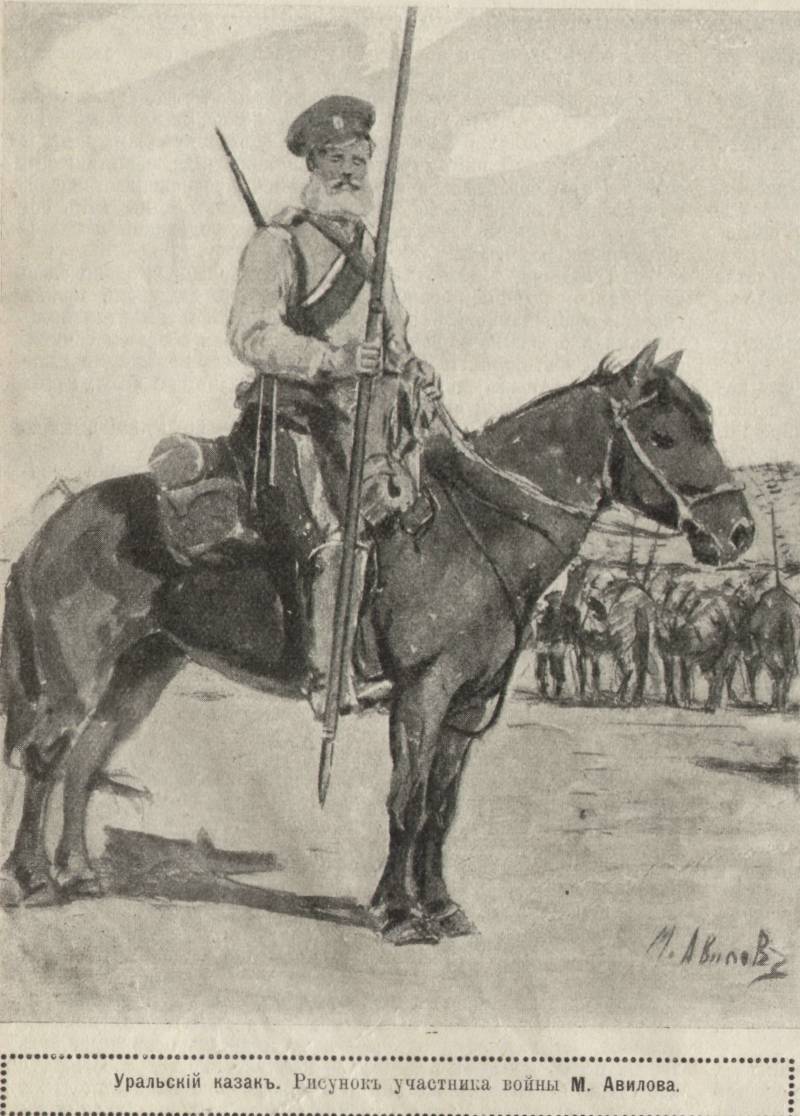Lampas under Prasnyshem. H. 3
So, on the night of February 11, the 1915 of the 1 Siberian Corps turned on the front of Mlodzyanovo-Old Town - and in the morning of the 11 the offensive began on the front of the Pike-Kozino. The Turkestan Cossack Brigade (8 hundreds with 8 mounted machine guns and two mountain implements assigned to it from the 2 Siberian Division) to the 7 11 watch was concentrated in Lukovo and was given the task of providing the left flank of the 1 Siberian corps. To the left, in the Kolachkovo-Opigur area, there were two cavalry brigades guarding the right flank of the 1 of the Turkestan Corps.
At 8 in the morning, two combat patrols were sent out with reconnaissance missions. In the 9 watch from Lukovo, the vanguard of the brigade (hundreds of Urals workers with 2 machine guns) spoke out, who was ordered to take Malenka and move depending on the reports of combat patrols. At the forefront was the headquarters of the brigade with 2 traveling. In the 9 hours, the 30 minutes of Malenka were occupied, and the vanguard was ordered to occupy Milevo Svejki and a large farm near this village. The brigade should go to Milevo Byki; one hundred of the Orenburg citizens, having entered into the submission of the chief of staff of the brigade, take Milevo Ronchka.
The day was foggy, visibility no more than 1,5 km, the movement was conducted carefully - patrols inspected almost every house. Speed and was not required, as the left flank of the 2-th Siberian division was moving with the usual speed for deployed infantry units.
In 11 hours, when the 5-th Siberian rifle regiment took Folv. Gelenov, the brigade took possession of Milevo Schweik; hundred Orenburg - Milevo Ronchka. The guns took up their position behind the pond in Milevo Svejki. There was no special cover, as five hundred settled in the huge yard of the farm, putting the horses in the stone cattle yards.
At noon, a report was received from the right side junction that there were no Germans in Kurovo, and Kozino was occupied by the enemy. The left voyage came back, finding out that there were no Germans in the New Whole.
The Urals received an order - one hundred to attack Kozino, and the other three to advance to New All - Filipy - Zbika Kerzhka. The Kozino attack started around the 11 hours of the 30 minutes and ended with the 11 hours of the 40 minutes. The attack was carried out by lava - from the spot to the gallop. Only one horse was lost, killed under the commander of hundreds of Captain Khoroshhin. A hundred broke into Kozino - the Germans, leaving up to a dozen corpses, fled to Venzhevo. Before the last one, trenches were quickly built.
Tabuly and Filipy were occupied without resistance (small German units quickly retreated to the north), and in Zbiki Kerzhka there was a rather strong German part - and the Urals had to attack the last point with artillery support (the mountain platoon fired more 60 shells). The soil thawed, and three hundred and two echelons (the first - one hundred at intervals in 15 steps, the second - two hundred in the deployed open order with intervals between rows 3 - 4 steps, distance between the ranks of 30 steps) trotted over the arable field. The Germans gave them several machine-gun bursts, but by 14 hours they left the village.
At the same time, a hundred Orenburg citizens knocked out a German outpost from Goronts.
By evening, several prisoners had gathered at the brigade headquarters, who belonged to different regiments of the 36 reserve division - their testimony made it possible to determine the approach of the new German formations.
From Goronts the Orenburg patrols contacted two companies of Turkestan riflers, who were seated at the cemetery in Zelena, and for two days fighting with 1 - 2 by the German battalions. Then, by patrols, it was found out that the German infantry occupied the trenches from Zelená to Gavronki, some of them occupied Zbiki Velk, and the Siberians occupied Venzhevo. The latter made the presence of a hundred in Kozino unnecessary, and Horoshin was ordered to transfer to the brigade reserve - in Milevo Shveyka.
The Don battery was sent to Kolachkovo, and the Turkestan brigade received a mountain platoon of the 2 Siberian artillery brigade.
The chief of staff of the 2 Siberian Division in his diary summed up the results of the day: “The Turkestan corps occupies the Kolachkovo-Osoyski-Sosnovo-Morgi line. There was no breakthrough in Opinogur ... The Turkestan Cossack Brigade, concentrating on Lukov, advanced its advanced hundreds to Novaya Vesa, and after us occupying Kozino, she was ordered to take Philip and Kerzhka. The detachment of mounted reconnaissance was transferred from Zaremba to Novaya Ves. .. "
So, the brigade did everything the infantry needed - and not by a written order, which was late, but on its own initiative. While in Zbika Kerzhka and Goronts, the brigade provided better infantry flank than staying in Kozino.
On the night of the 12, the Germans were sleeping, the Siberians were preparing to attack Krasne and the German positions north of this village, and the brigade was feeding horses. At night, the 15-I cavalry division approached, settling down one brigade in Filipa and another in Grabovo.
In 8 hours, the Turkestan brigade was located: 3 hundreds of Urals were located on the northern outskirts of Zbika - Kerzhka (horse breeders - in sheds on the southern outskirts of the village), 3 hundreds of Orenburg residents were in Goronts, brigade reserve and headquarters - in Filipy, and two mountain guns (obr 1904 g.) Were placed at the disposal of the commander of the 2 Ural Regiment and settled in a position in the barn in Zbika Kerzhka - ready to support the Urals.
Smash the 1 of the backup corps. The pursuit.
The 2 th Siberian corps reached Krasnoselts, and the 4 th cavalry division guarded its rear (later the 39 th Siberian rifle regiment took up this task).
It would seem that the 4 th cavalry division had to be moved to the right flank of the 2 Siberian Corps and cut off the Germans on the way to Khorzhele and Yanov, but ... The 2 Siberian Corps was part of the 1, and the 4 division was 12 Army, and the latter, of course, kept the division at home. By evening, the 2 th Siberian corps reached Karvach, and the 1 th Siberian corps began the attack on Krasne in the morning.
The attack from the front on the unsettled infantry did not promise immediate success - and the Turkestans began to prepare it with all available means: three hundred Ural residents dismounted and settled on the northern outskirts of Zbika Kerzhka (with them machine guns and a mountain artillery platoon); three hundred Orenburg residents occupied Goronts.
At about 10 hours, the commander of the 2 of the Ural regiment of the military foreman S. P. Shadrin reported that his right flank is not secured - and the chief of staff of the Turkestan brigade advanced from the reserve 4 of the hundred Cossack regiment under the command of the ia-saver to create a X-ray sweeper under the command of the ia-sahu. the gap between the Siberians and, if necessary, to support the attack of the latter.
A mountain artillery platoon climbed into the ditch at Zbiki Kerzhki and from there fired at the German trenches in front of the folk. Zbika Starkey. The low weight and size of the guns turned out to be more important than their power.
With 11 hours, only firefighting was fought - mainly between the Urals and the Germans, who occupied the trenches between the folk. 3biki Starks and Zelena.
Hundreds of Pechenkin, knocking out a German outpost from Zbika Velk, hid behind houses and watched the course of the battle with the Siberians. Near the 14 watch Urals made an attempt to attack the folk. Zbika Starkey on foot - but, having overcome half the distance to the enemy and reaching the saddle, they came under the strongest rifle and machine-gun fire and were able to retreat only under the cover of the fire of a mountain artillery platoon. The Cossacks were lucky that they had a good shelter - a stone fence about 600 long steps - and almost 160 people were hiding behind it.
The firefight was fought until 16 hours, when the commander of the Turkestan brigade received the following reports: a) from Esaul Pechenkin: “Siberians advance like a parade, attacking with them”; b) from the commander of the Ural regiment - “I suppose to go on horseback”; c) from the commander of the mountain artillery platoon: “only 55 shots are left”.
The message of Pechenkin was left unanswered, the commander of the Urals received a blessing on the attack, and the gunners were ordered to release all the shells.
During this period, the Cossacks distinguished themselves - they managed to implement several successful equestrian attacks.
The 6 th Siberian Rifle Regiment attacked Bobovo. An eyewitness recalled how the Siberians attacked: “quickly, as on a parade, without bending down or running across; the commanders of the company are clearly visible in front, and the platoons are behind their units. Shooting subsided ... ". Pechenkin took advantage of this: when Siberians were in 200 - 300 steps from the German trenches, his 4-I hundred of Orenburg people in the 6 column rushed in the direction of the folv. Bobovo. The Germans fired hard at Siberians, and a hundred passed through the ranks of the latter almost without loss. German bullets flew over the riders, and many arrows screamed and grabbed the stirrups and horse tails and, along with hundreds, broke into the German trenches. The shots of the riflemen were heard: "Cavalry ahead, hurry up." The Cossacks were ahead of the chain no more than steps on 30 - 50, breaking into the ranks of the Germans. Another minute, and hundreds were gone: she scattered, chasing the runners.
Everywhere were visible Germans running. In folv. Bobovo, a hundred of three German guns that had not had time to withdraw from the position slipped. Several Cossacks rode to them. One of the Cossacks reported: "The Germans threw revolvers, raised their hands up, I drove around them three times around and galloped on." Separate Cossacks rode up to Lisiogur. The commander of the hundreds of Solomov alone attacked the German platoon - the latter dropped his rifles and then was captured by the arrows. Then the sergeant-general rushed into the forest south of Lisiogur, but fell under machine-gun fire, fell off his horse and was picked up by a Cossack of the 3-Ural Regiment of the 15-th Cavalry Division. Both Cossacks returned back, sitting together on one horse.
Urals were attacked. While the mountain artillery platoon was launching the last shells, the chain of dismounted Cossacks of the 2-Ural regiment ran to the horses and then rushed forward - towards the folk. Zbika Starkey. Here the Germans did not wait for the attack, and their fire assumed a disorderly character and gradually froze. Perhaps the Germans saw the attackers only when they emerged in the gathering twilight due to the bend of the ramp. With a shout of “Hurray!”, The Urals on the gait rushed to the attack - and the Germans, not accepting the attack, partially rushed to run, and partially raised their hands up. Having lost one contractor, in a quarter of an hour the Urals residents cleared the area between Gavronki, Anttos and Zelena from the enemy.
Ural Cossacks.
Even before the start of their attack, equestrian reconnaissance men of the 2 Siberian Division passed at Zbika Belka at a trot — they attacked after hundreds of Pechenkin.
Orenburg marched to Zelena - but the Germans had already managed to move.
The commander of the 2 brigade of the Siberian Division, Major General M. D. Enchevich, in a field note testified that the Cossacks Esaul Pechenkin were the first to introduce death and panic into the ranks of the Germans. His hundred prisoners did not lead (but 3 light weapons, picked up by infantry, became trophies of the Orenburg people). The 6 th Siberian regiment captivated the 700 man, the same number was led by the hussars of the 15 th Cavalry Division, almost as many by the 2 th Ural regiment (and the prisoners were from five different battalions) and about a thousand Germans led the 3 th Ural regiment.

M. D. Enchevich.
Losses in these attacks: Orenburzhtsy - 2 Cossack and 6 horses (a hundred gathered only in the morning); Urals - 3 Cossack and a few horses.
1 th Turkestan Corps threw the Germans and he went on the offensive. The total number of prisoners on that day (a telegram from the Chief of the Corps of Major General Ia. K. Tsikhovich) reached 10000 people.
The darkness, the viscous soil and the fatigue of the horses did not allow the attackers to continue the pursuit. To complete the defeat of the Germans, the 1 th brigade of the 15 Cavalry Division and the entire squadron V. A. Himets should be brought into battle - by sending the cavalry at night to Prasnysh - Khorzhele.
The 13 of February The 2 of the Siberian Corps crossed Hungarian at Dobrzhankovo and to the north and forced the German rear guards and the “fresh forces” Galvits to retreat. 1-th Siberian Corps to 16-hours entered in Prasnysh.
The Turkestan Cossack Brigade, gathering three less weary hundreds, sent them north to help the Siberians. In the diary of the chief of staff of the brigade it is noted that he was on this day in folk. Zbika Starkey with the banners of two regiments, four machine guns and the last hundred of the Urals.
The 2 Brigade of the 15 Division remained in Philippu, and the 1 Brigade passed through Folv. Zbika Starkey and in the evening reached Chernitsa Borov.
One hundred Turkestans still managed to chop the retreating Germans on the highway to Gruduk. This ended the pursuit on the battlefield.
14 February 1 th and 2 th Siberian corps begin pursuit in the directions of Horzhel and Dzerzhgovo, and from the cavalry only the Turkestan brigade moves on Horzhel - in the vanguard of the 2 th Siberian. On February 15, the German cavalry first appeared on the scene - two squadrons of which were driven out by the Turkestanians from Adama. And on February 16 south of Khorjele, a weather vane of Saxon dragoons was noticed.
Horzhele Germans received new reinforcements. But the North-West theater theater has stabilized - a trench seat began, which lasted until the new operation Galvitsa (Third Prasnyshskaya) in July 1915.
Conclusions.
As Moltke the Elder once aptly remarked, deployment errors often cannot be corrected during the entire campaign — and this phrase applies to the error in placing the Russian cavalry to the start of the operation. The concentration of V.Khimets’s detachment “in the name of massaging” was good for solving offensive tasks, but, as long as the Turkestan corps needed to be defended, it left much to be desired.
Squeezed in a narrow space, and then trapped in a narrow corridor between the advancing German corps, the cavalry could barely jump into the space she needed - and only then stopped the German offensive. But at a high price - the price of premature entry into battle.
At the beginning of the German offensive, two detachment brigades used various methods of action: the 4-i was artillery, “hanging” on the flank of the 1-second reserve corps, and the Turkestans dismounted, bringing the case to the rifle.
The imprint of the terrain and the specificity of the terrain: two small partitions (Ural and cornet Kadoshnikov) were captured in the forests one by one (but extremely necessary) by the prisoner. At the same time, reconnaissance detachments that were tied to the roads failed to take languages. It was possible to reveal the flank of the German offensive - in a few hours having passed from Poppies to Krasnoselts.
The cavalry had to act on a very long front.
On February 10, the Turkestan brigade occupied the 10-km front and “persuaded” its highly valiant opponent to “not push”. V. A. Chimets successfully covered the gap also about 10 km - but with two brigades.
The tasks during this period did not require any independent, decisive blow to the enemy - it was necessary to gain time for the approach of the Siberians. This could be achieved by leading a fire impact (albeit symbolic) on the enemy on a long front. Daily battles - here and there - forced the Germans to turn around, conduct reconnaissance, and turn back again - spending precious time. The cavalry was able to reject the enemy that broke through in some areas - 9 in February from Elzhbetovo and 10 in February from Zalesye.
11-th, thanks to the fog, the Turkestans successfully carry out several small equestrian attacks on the infantry escort of the Germans - frontal attacks almost without any preparation.
The 12 is brewing a decisive blow to the Russian infantry, and the cavalry assists it.
Turkestans hurried six hundred out of eight and prepared to attack with fire.
Turkestans especially distinguished themselves. They were not late by that moment, which one of the tactical experts of those years defined as “the sacred moment when the telephonist puts his pipe aside, and the sapper shovel, and everyone rushes to take part in the last parade.”
The example of Pechenkin shows how convenient the moment is when an infantry approached the enemy.
The results of the cavalry attacks were enormous: over 2500 captured Germans showed that at least 20 enemy full mouths were scattered in a few hours. It would have taken the infantry to "gnaw" the enemy defense a lot more time and also cost a lot of casualties.
The first echelons of the attackers (Turkestans) were scattered so that they then gathered the whole night. At the same time, any attack has its limit - and even two brigades did not manage to overcome German machine guns that were in 3 - 4 kilometers from the front edge. We needed new trains (which were absent), reinforced, if possible, with armored cars. This would not allow German rearguards to form and helped to overcome the enemy’s machine gun curtain.
The terrain (an almost flat field, villages and woods) was generally favorable to the actions of the cavalry — there were no obstacles on it that delayed the cavalry. But at the same time, there was no shelter from the fire, which could inflict severe losses on the cavalry - but ... did not inflict. After all, the Russian cavalry acted tactically competently, correctly selecting the points and time of the attack.
23 Russian squadrons and hundreds took part in these battles (but with better organization they could attack 33). Finally, it is worth noting the huge (especially for the cavalry) role of the commander’s initiative — at the level of a hundred — a squadron.
We see that the Russian cavalry fulfilled the most important tasks - reconnaissance, shock and to cover the joints between the units and entire areas, contributing to the victory of the Russian weapons in the Second Prasnysh operation.



Information